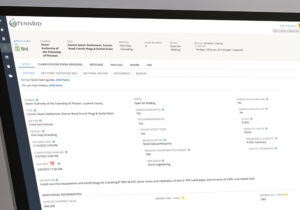For more information on PennBid, contact us or request a 30 minute overview.
The PennBid Program
Online Bid Management Made Easy

Electronic bid management, e-procurement, online bidding, and e-purchasing. By now, you’ve likely heard one or more of these terms. Often used interchangeably, they refer to the process of conducting competitive bidding electronically, via the internet, instead of the traditional way with paper and sealed envelopes.
Understandably, public agencies, including authorities, may be skeptical about a new(er) practice like electronic bidding since most have only done it one way – with paper – and understand the importance of adhering to procurement codes. Also, some may have concerns that electronic bidding will fundamentally change what they do, when in fact, it only changes how they do it.
Email, for example, doesn’t change the fact that a person is communicating in writing. Instead, it makes the task faster and easier.
In The Beginning
In the mid-1990s, private-sector companies realized that leveraging technologies, such as computers, electronic files, and the internet, could yield significant savings in the purchasing process.
Accordingly, web-based applications were developed that streamlined the time- and resource-intensive process of paper-based bidding. Numerous studies have shown that agencies can save an average of 2 percent to 5 percent of their total project costs when they switch to electronic bid management. Applied across the board, these figures represent real purchasing savings that can’t be ignored.
About this same time, legislators in Pennsylvania started paying attention to the purchasing efficiencies that technology promised, and by 2006, they enacted two laws that permitted electronic bid management. The first, the Electronic Transactions Act (Act 69 of 1999), made electronic transactions and signatures legally binding.
The more essential piece of legislation, though, was the Local Government Unit Electronic Bidding Act (Act 88 of 2006). It amended the commonwealth’s Procurement Code to allow local government agencies, including municipalities, school districts, councils of government, authorities, and others, to purchase products and services with online bidding.
With the technology refined and legislation in place, the conditions were ripe for something great to happen.
The Birth of PennBid
The Bucks County Consortium (BCC), a group of 38 public entities and authorities in southeastern Pennsylvania, was one of the first to support electronic bid management. The BCC’s foresight coupled with a state-of-the-art software application led the consortium to embark on a public-private collaboration with a small Pennsylvania-based firm. Soon after, PennBid was born.
Then and now, PennBid’s purpose is to save time and money for everyone involved in bidding. Aside from financial savings, PennBid’s founder insisted that the platform provide a more transparent process and greater vendor inclusion. The program’s unique partnership also established an equally unique business model that PennBid follows to this day.
- PennBid is provided at NO COST to public agencies that post and manage bids. This includes authorities, municipalities, school districts, colleges, non-profits, and their design firms.
- Bidders also pay nothing to participate (no membership or subscription fees). PennBid provides them with the tools and documents to submit bids electronically – and successfully.
- PennBid charges one, nominal fee, which is levied on successful vendors (those awarded the contract) and is capped so that it’s not prohibitive. Bidders who do not win pay nothing.
This business model is a true “win-win” for all parties. It allows public agencies to implement a state-of-the-art, web-based bid management program while enabling bidders to participate in the public procurement process – all with no risk or financial investment.
Benefits Of PennBid
Electronic bidding doesn’t change the requirements that agencies must follow. Also, PennBid does not impose requirements on users. It is simply a vehicle that dramatically streamlines the exchange of documents, information, and bid submissions. This is achieved through numerous features and capabilities in the system that result in many benefits.
For bidders, the advantages include:
- Paying nothing to participate, obtain plans and bidding documents, and submit bids.
- Receiving auto-notifications of new opportunities based on products and services provided and desired work locations.
- Easily submitting and editing bids; accessing required forms, such as bid bonds, non-collusion affidavits, and qualifications statements; following specific bidding opportunities; and submitting and reviewing questions and answers.
- System calculates line-item extension prices, which minimizes math errors.
For posting agencies and design firms:
- Costs nothing to implement, including training and ongoing support.
- Used for all types of bids, including requests for proposals, requests for bids, requests for qualifications, multi-prime construction contracts, and more.
- Standardizes the purchasing process regardless of size or type of bid.
- Offers potentially significant savings on bid advertisements.
- Eliminates paper documents and their costs.
- Maintains confidentiality of sealed bids until bid opening.
- Access to a huge population of potential bidders.
- Provides rapid, consistent, and verifiable communications with all bidders.
- Eliminates math errors and incomplete bid submissions.
- Provides “cloning” to facilitate repetitive or seasonal bids.
- Enhances record retention, transparency, risk management, analytics, and reporting.
Looking Back With Gratitude
In reflection, we thank PMAA leadership and the board of directors for recognizing PennBid’s significant savings and other benefits for their members and for supporting and endorsing the Program for more than a decade. We are also thankful and humbled that more than 1,200 public agencies and design firms have come to trust PennBid as a reliable partner for all their bid management needs.
